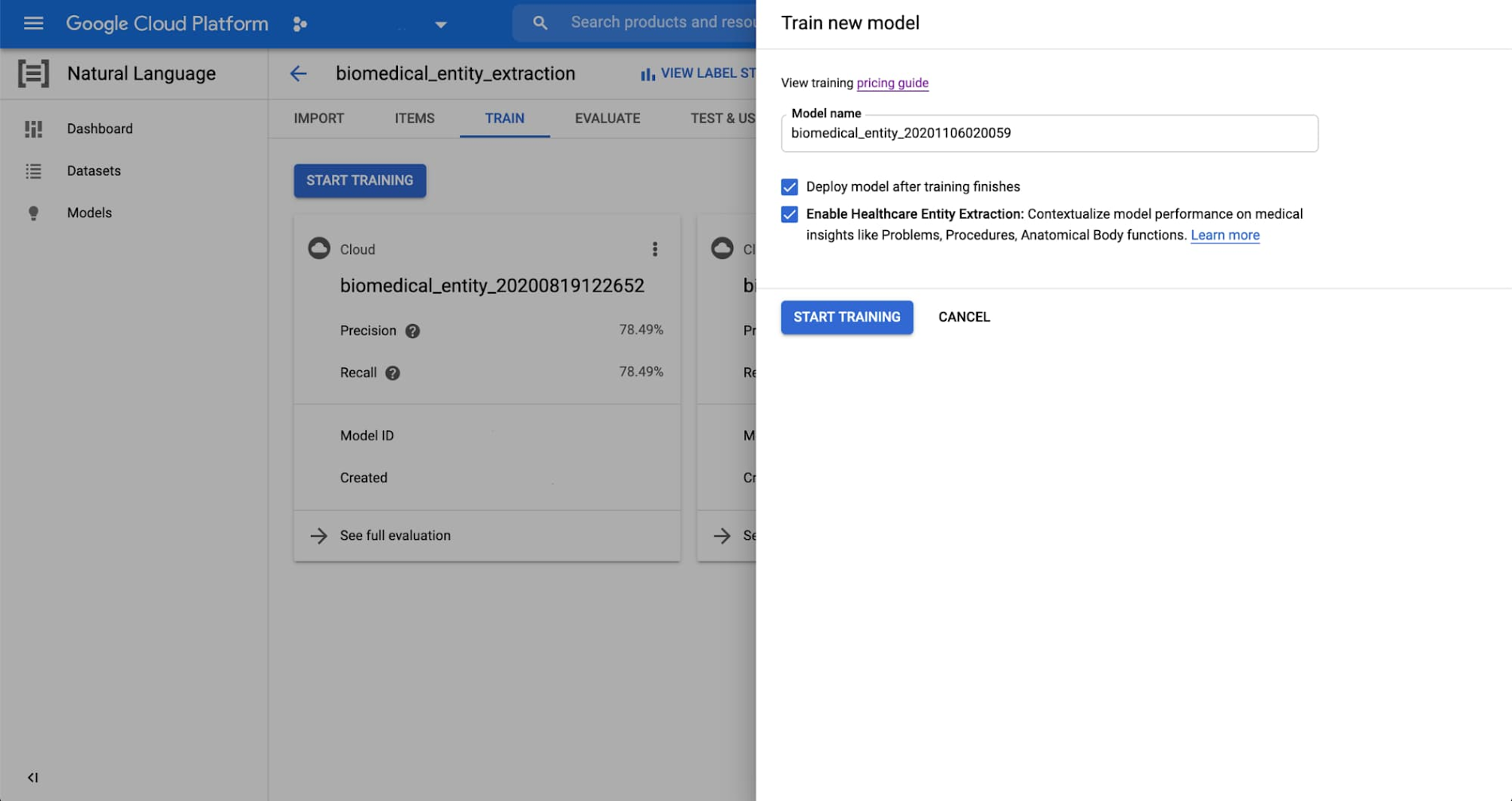Healthcare gets more productive with new industry-specific AI tools
Andreea Bodnari
Product Manager
COVID-19 shined a light on the heroic efforts of front-line healthcare workers. But it also highlighted some of the challenges around managing healthcare data and interpreting unstructured digital text. For healthcare professionals, the process of reviewing and writing medical documents is incredibly labor-intensive. And the lack of intelligent, easy-to-use tools to assist with the unique requirements of medical documentation creates data capturing errors, a diminished patient-doctor experience, and physician burnout.
Today, we are excited to launch in public preview a suite of fully-managed AI tools designed to help with these challenges: Healthcare Natural Language API and AutoML Entity Extraction for Healthcare. These tools assist healthcare professionals with the review and analysis of medical documents in a repeatable, scalable way. We hope this technology will help reduce workforce burnout and increase healthcare productivity, both in the back-office and in clinical practice.
Healthcare Natural Language API enables auto summarization of medical insights
A significant pain point in the healthcare industry is that mission-critical medical knowledge is often stored in unstructured digital text—that is, content lacking metadata that can’t be mapped into standard database fields. For example, social determinants of health like substance abuse or physical activity, and follow-up recommendations such as medication amounts or behavior suggestions, often reside within the unstructured text of a medical record. The main path to accessing such information is a manual review of the medical document by the healthcare professional.
With the Healthcare Natural Language API, enterprise customers can now better coordinate valuable medical insights that are captured in unstructured text, such as vaccinations or medications, that may be overlooked as patients move through their healthcare journeys. This solution can drive measurable outcomes by lowering the likelihood of redundant bloodwork or other tests, reducing operational spending, and improving the patient-doctor experience.
How does it work? The Healthcare Natural Language API identifies medical insights in documents, automatically extracting knowledge about medical procedures, medications, body vitals, or medical conditions. By using machine learning, the API identifies clinically relevant attributes based on the surrounding context. For example, it discerns medications prescribed in the past from medications prescribed for the future and it picks up the likelihood of a specific symptom or diagnosis, as captured in language nuances. It can also distinguish medical insights that pertain to the patient from information that pertain to a patient’s relative.


To facilitate analysis of medical insights at scale, the Healthcare Natural Language API automatically normalizes medical information against an industry-standard knowledge graph such as Medical Subject Headings (MeSH) or International Classification of Diseases (ICD). Human language is rich in concepts—often with overlapping meaning—yet analysis necessitates standardized data inputs. For example, the medical condition diabetes is commonly referred to as diabetes mellitus, while croup is also called laryngotracheobronchitis in specialist terms. With the Healthcare Natural Language API, similar medical information gets normalized into a standardized medical knowledge graph.
Finally, the Healthcare Natural Language API enriches health applications that rely on the interpretation of unstructured digital text. For example, telehealth companies can deploy the Healthcare Natural Language API to identify the most relevant symptoms, pre-existing conditions, and medications from a doctor-patient transcribed conversation. Pharmaceutical and biotechnology customers may employ the Healthcare Natural Language API to optimize clinical trials by increasing the accuracy of patients matched against granular inclusion/exclusion protocol criteria. The Healthcare Natural Language API technology can also drive operational efficiencies in document-review workflows like Healthcare Effectiveness Data and Information Set (HEDIS) quality reporting or Hierarchical Condition Category (HCC) risk adjustment.
AutoML Entity Extraction for Healthcare facilitates custom information extraction
In addition to the Healthcare Natural Language API, we are launching AutoML Entity Extraction for Healthcare—an easy-to-use AI development platform that broadens access to AI across users with various technical backgrounds. AutoML Entity Extraction for Healthcare complements the coverage of insights available through the Healthcare Natural Language API.
Healthcare professionals may not have the technical expertise on-hand to build their own tools for extracting information from digital documents. With AutoML Entity Extraction for Healthcare, we've made this much easier to do via a low-code interface, letting healthcare professionals build information extraction tools for gene mutations and socioeconomic factors, for example. AutoML Entity Extraction for Healthcare enriches digital health applications such as telemedicine, drug discovery, or clinical trials for rare diseases.


To help customers get started with AutoML Entity Extraction for Healthcare, we are open-sourcing a set of annotation guidelines for medical text. We hope the community will contribute to the refinement and expansion of these guidelines to mirror the ever-evolving nature of healthcare.
Accelerating impact through partners
To help deliver these solutions to providers, payers, and life science companies nationwide, Google Cloud is partnering with a number of key solutions providers. SADA, a Google Cloud solutions provider, believes the new tools will be able to help healthcare customers implement medical analysis projects in days, not weeks.
“The richest information about the health of a patient is typically not found within the structured fields of a medical record system. Instead, it is contained within the lengthy free-text notes that a clinician either types or dictates into the medical record in the course of care,” says Michael Ames, Sr. Director Healthcare and Life Sciences at SADA. “I'm very excited for the opportunities this suite of Healthcare Natural Language AI tools from Google Cloud will create.”
What’s next
Learn more about getting started with the Healthcare Natural Language API, which is free-of-charge for the next 30 days, until December 10th, 2020. To get started with the public preview of AutoML Entity Extraction for Healthcare, see our step-by-step guide and check out our website, or contact sales for more information.



